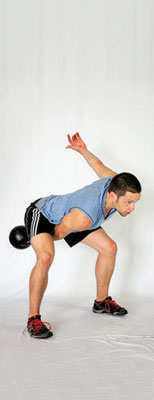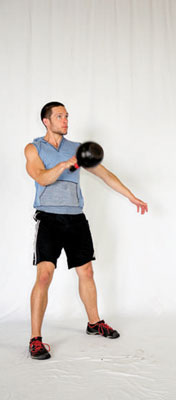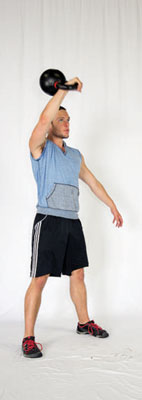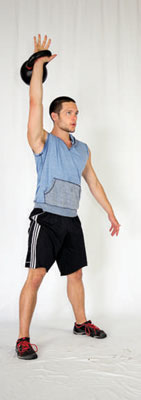To perform the snatch, you swing the weight back between your legs and bring it up over your head in one smooth, uninterrupted motion. This movement brings you to the pinnacle of your primal hinging progressions.
If you haven’t spent adequate time perfecting your swings, one-arm swings, and cleans, you’re not ready for the snatch.
The snatch manufactures the raw power and “never say die” conditioning of an Olympian. And when applied liberally, it blasts body fat like a blowtorch.
Kettlebell and dumbbell snatches are more forgiving, easier to learn, and don’t require an Olympic lifting platform. Here’s how to do the snatch:
Set up behind the weight (kettlebell or dumbbell) and hike the weight forcefully back between your legs.

Drive your hips forward and explode out of the hinge. Imagine you’re trying to jump through your heels.
To do the snatch right, you have to fully commit yourself to the movement; otherwise, the bell won’t go where it needs to. Be sure to snap those hips!
As the weight accelerates upward, keep your elbow in close to the body, guiding the weight up your center line (not letting it arch out wildly).

This portion of the snatch is sometimes referred to as the high pull. Notice how the elbow is slightly bent and stays relatively in line with the body. This form ensures an efficient trajectory. The further the weight gets away from you on the way up, the less efficient the movement, so keep it tight.
If using a kettlebell, practice “punching” through the bell around eye level to ensure a smooth transfer of the weight onto the forearm.

When you go to punch through the bell, be sure to loosen your grip to avoid tearing any callouses. It may even help if you “spear” through the bell and open your hand entirely.
Finish the snatch overhead in a fully lockout position; that is, lock your elbow and line your bicep with or slightly behind your ear.

It will take some time to find your groove, but in the end, the snatch should be one smooth and graceful movement.
To avoid unnecessary callous tears when using kettlebells, maintain a relatively loose grip. Hold on just tight enough to keep the bell in your possession but loose enough so the handle may rotate without grinding up your hands.

